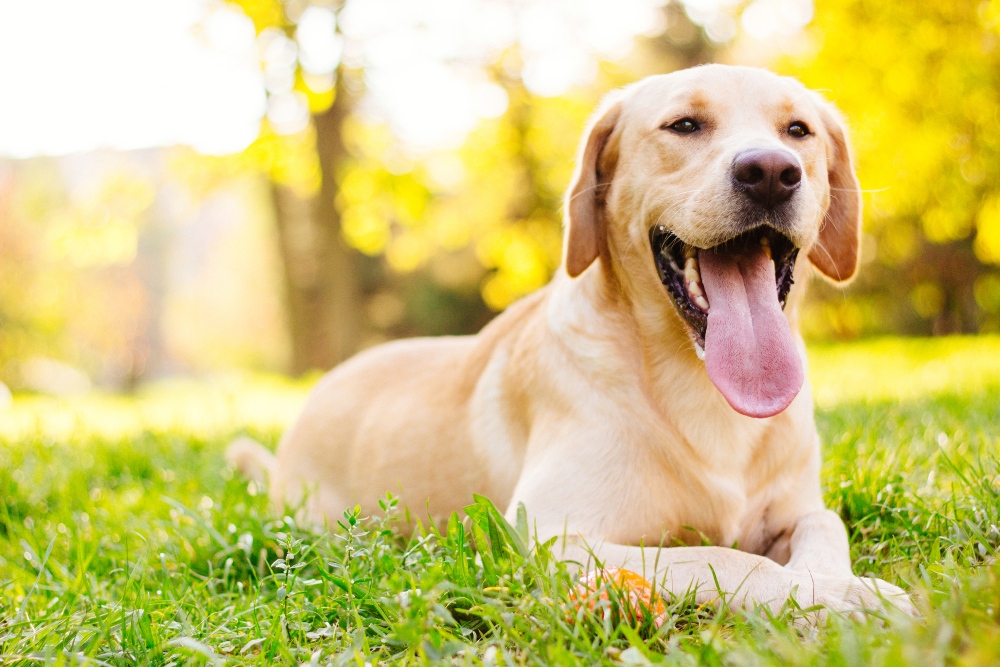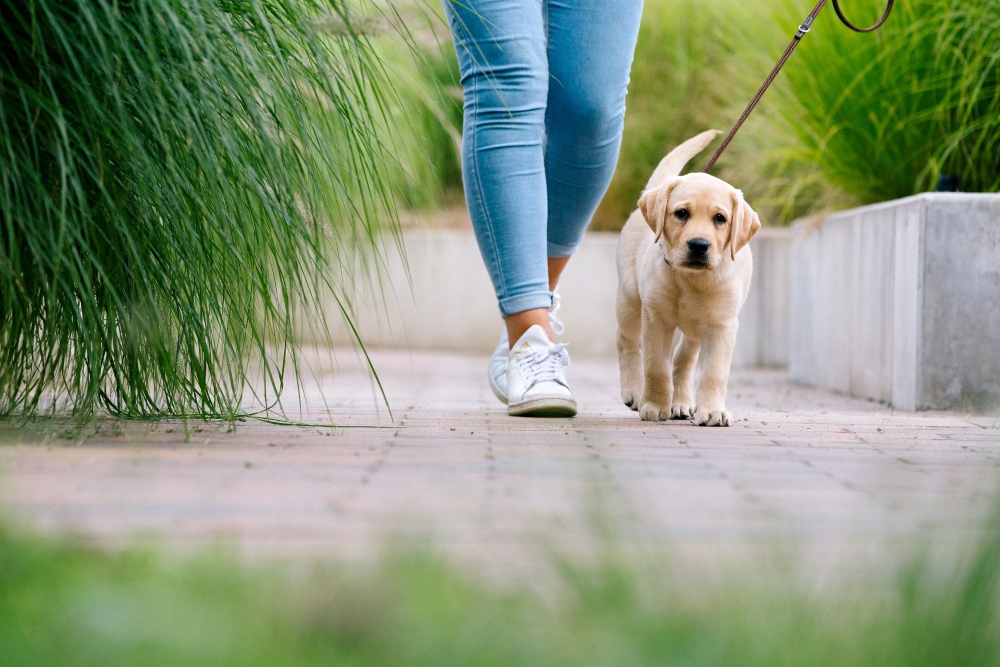Table of Contents
Introduction to Labrador Retrievers
Labrador retrievers are among the most popular dog breeds in the entire world – and for good reason! These dogs are friendly, outgoing, lovable, and active. They have a sweet appearance and demeanor, and they have lots of energy to get outside with the people they love.
These medium-to-large dogs are known for their ability to bond with people and socialize well with other dogs. However, these enthusiastic canines need a lot of exercise to stay healthy and mentally stimulated, so you’ll need to have plenty of time to devote to your Labrador retriever.
If you have been wanting a Labrador retriever in your life, read on to learn more about this breed and how to take the best care of your Labrador retriever’s health with Healthy Paws pet insurance.
Size of Labrador Retrievers
Adult male Labrador retrievers grow to be 65 to 80 pounds, while adult females typically weigh between 55 and 70 pounds. The males in this breed stand 22.5 to 24.5 inches tall, and the females stand 21.5 to 23.5 inches when fully grown. These dogs generally reach their adult size around one year of age.
Here’s how big you can expect your Labrador retriever to get as he or she gets older and progresses from puppyhood to senior dog status:
| Weight Chart | 3 mos. | 6 mos. | 9 mos. | 12 mos. | 24 mos. |
| Average for male Labrador retrievers | 24 lbs. | 45 lbs. | 62.5 lbs. | 70.5 lbs. | 72 lbs. |
| Average for female Labrador retrievers | 23 lbs. | 44 lbs. | 55 lbs. | 61.5 lbs. | 62.5 lbs. |
Characteristics of Labrador Retrievers
Numerous adjectives are used to describe Labrador retrievers, such as good-natured, hard-working, and social. Labrador retrievers were bred to help fishermen by fetching ropes, retrieving fish, and carrying nets. Although most modern Labs are household companions rather than working dogs, this breed still excels at various jobs, such as rescue work, guide assistance, and competition sports.
It’s relatively easy to bring a Labrador retriever into your home because of how friendly this breed is with kids, pets, and even strangers. They are easy to groom but do need a strict diet to avoid obesity and related health problems. They are moderately adaptable dogs, tolerant to many weather conditions, and very energetic.

As you get to know a Labrador retriever’s personality, here’s what you can expect based on his or her breed characteristics:
| Breed Characteristic | Level (High, Medium, Low) |
| Affectionate with People | High |
| Good with Kids | High |
| Good with Pets | High |
| Need for Exercise | High |
| Energy Level | High |
| Intelligence Level | High |
| Able to Be Trained | High |
| Amount of Barking | Medium |
| Amount of Shedding | Medium |
History of Labrador Retrievers
The history of the Labrador retriever dates back to the early 1800s when this breed was used as waterdogs in Newfoundland, Canada. The dogs were used to retrieve ducks for hunters and as fishing mates. Their usefulness caught on with English noblemen who visited Canada and brought them back to their country.
Labrador retrievers have always been great for working purposes because of their dense, short, and weather-resistant coats. Longhaired retrievers were well-suited for Canadian winters and even retrieving prey from icy waters. Meanwhile, these dogs are great swimmers because of their otter-like tails that work like a rudder, moving back and forth in the water while the dog swims. The Kennel Club in England officially recognized this breed of dog in 1903, and the American Kennel Club registered its first Labrador retriever dog in 1917.
Labrador Retriever Standard Information
Pet owners often enter Labrador retrievers in dog shows where they are judged based on appearance, agility, and other characteristics. Overall, these dogs are athletic, well-balanced, and intelligent. A Labrador retriever has kind eyes, a good temperament, powerful jaws, a weather-resistant coat, and an otter-like tail.
Here is an overview of the breed standard information for Labrador retrievers:
Head:
- Wide and well-developed skull
- Muzzle neither long and narrow, nor short and stubby
- Wide nose with well-developed nostrils
- Teeth in a scissors bite
- Ears hang moderately close to head
- Friendly eyes that are brown in black and yellow Labs or brown/hazel in chocolate Labs
Neck, Topline, Body:
- Neck muscular and free from throatiness
- Back strong and topline level
- Short-coupled body with good spring of ribs
- Thick tail at base that gradually tapers towards tip
Forequarters:
- Muscular forequarters and well-laid back shoulders
- Length of shoulder blades equal length of upper arm
- Elbows close to ribs without looseness
- Feet strong and compact with well-arched toes
Hindquarters:
- Broad and muscular hindquarters
- Hind legs strongly boned and muscled
- Toes only slightly behind point of the rump
- Well-arched toes and well-developed pads
Coat:
- Short, straight, and very dense coat
- Soft, weather-resistant undercoat
- Slight wave down the back is permissible
Color:
- Black, yellow, and chocolate colors
- Small white spot on chest is permissible but not desirable
Gait:
- Free and effortless movement
- No sign of elbows out during movement
- Hind legs move as nearly as possible in parallel line with front legs

Caring for Labrador Retriever
Taking care of a Labrador retriever is quite a joy because of how affectionate this breed is with people. However, these dogs love spending time outdoors and need owners who want to be outside and active too.
They make wonderful family dogs but do best with ample social interaction and mental stimulation. Otherwise, they have a tendency to dig and chew in potentially destructive ways.
Some general tips for taking the best care of a Labrador retriever include the following:
Best Living Environments:
- Houses with fenced-in yards
- Not ideal for apartment living
- Homes with children, dogs, or cats
Type of Exercise:
- At least 30 to 60 minutes of exercise per day
- Swimming in outdoor bodies of water or pools
- Hiking, walking, and running with people
- Playtime with toys in a yard
Mental Enrichment:
- Agility tests
- Games of fetch
- Dog show competitions
- Puzzle toys
Training Strategies:
- Sign up for training early to teach good manners
- Does best when having a job to do
- Consider keeping in a crate or kennel when gone if prone to chewing household items
Grooming Tips:
- Be prepared for shedding
- Brush daily to get rid of excess fur
- Bathe every other month
- Brush teeth daily
- Keep nails trimmed once a month, unless worn down naturally from exercise
Common Health Problems in Labrador Retrievers
The average life expectancy of a Labrador retriever is 11 to 13 years. This is a generally healthy breed, but there are still some health concerns that pet parents should be aware of.
These are some of the most common health issues that arise among Labrador retrievers:
- Ear infections
- Tricuspid valve dysplasia (heart issue)
- Hip dysplasia
- Elbow dysplasia
- Centronuclear myopathy (skeletal muscle disease)
- Hemangiosarcoma (cancer)
- Exercise-induced collapse (neuromuscular disease)
- Progressive retinal atrophy (eye disease)

Diet and Nutrition for Labrador Retrievers
It is important to feed your Labrador retriever a high-quality, puppy-formula dog food until your dog is one year old. After that, you can switch to an adult dog food for large breeds. Most Labrador retrievers need 2.5 to 3 cups of dry dog food per day. Divide this total amount into two meals per day.
Where to Adopt or Purchase Labrador Retrievers
Many people choose to purchase pure Labrador retrievers from breeders, but it is best to choose a responsible and reputable breeder that you can trust. The Labrador Retriever Club is the national breed club for Labs and offers a breeder directory to search for a new pup.
The club also provides resources for rescue organizations and has a national rescue fund that accepts donations. At animal shelters, you will often find Lab mix dogs that have a bit of Lab in them plus some genetics from other dog breeds too. These mixed-breed dogs in need of good homes make amazing pets and share many of the same characteristics as pure Labradors.
Related Breeds
It’s hard not to love a Labrador retriever, but there are other dogs that you might fall in love with too if you are interested in this breed. Here are some similar types of dogs to consider before settling on a Labrador retriever.
- Golden retriever
- Bernese mountain dog
- Bassador
- Sheprador
- Corgidor
- Labradoodle
Pet Insurance for Labrador Retrievers
To address the various health concerns noted above and plan ahead for your Labrador retriever’s future health, it is important to get pet insurance for your pup. Just like we, as humans, have health insurance, Labs benefit from health insurance too when costly veterinary bills start adding up.
At Healthy Paws, we offer Lab insurance that covers illnesses, accidents, genetic conditions, breed-specific conditions, emergency care, alternative care, and more. Get your instant online pet insurance quote today and feel confident that you can always take the very best care of your Labrador retriever’s health.








